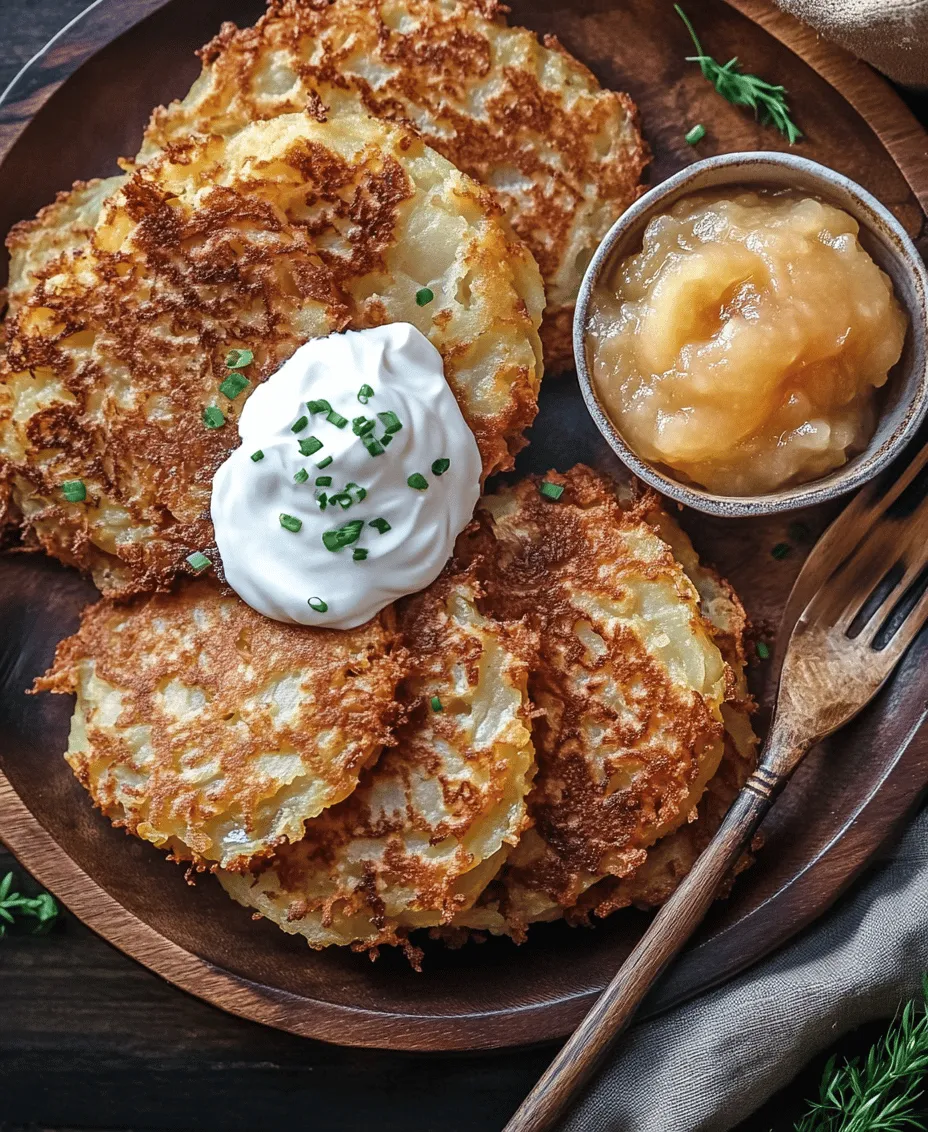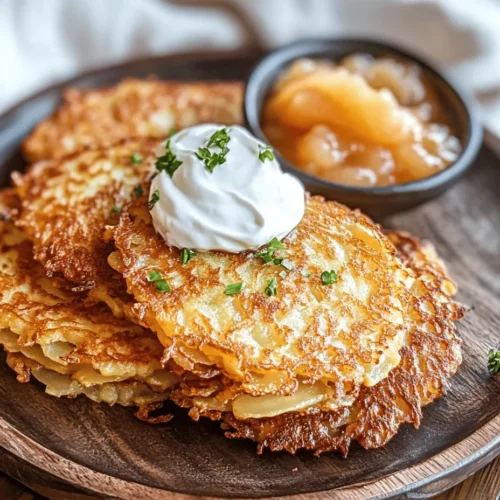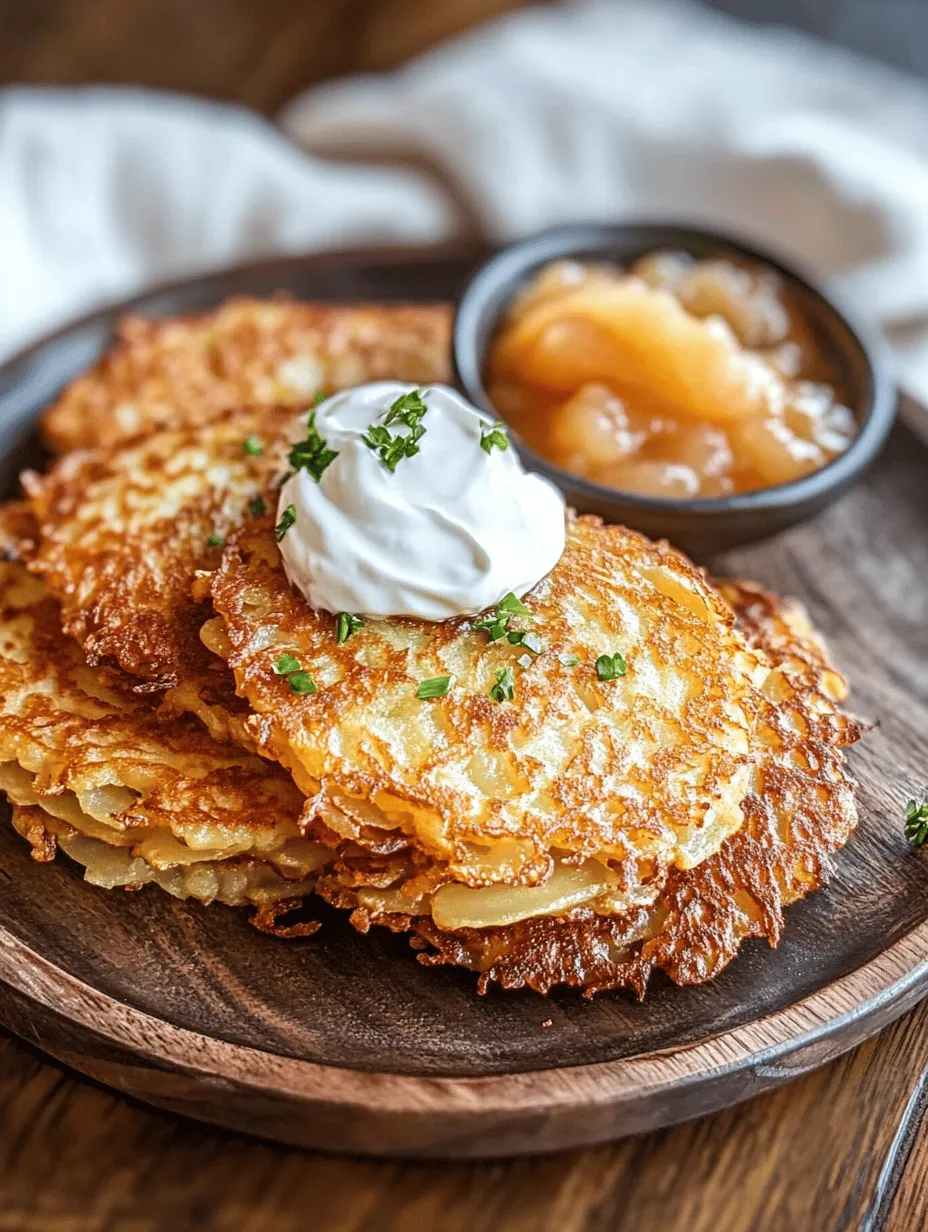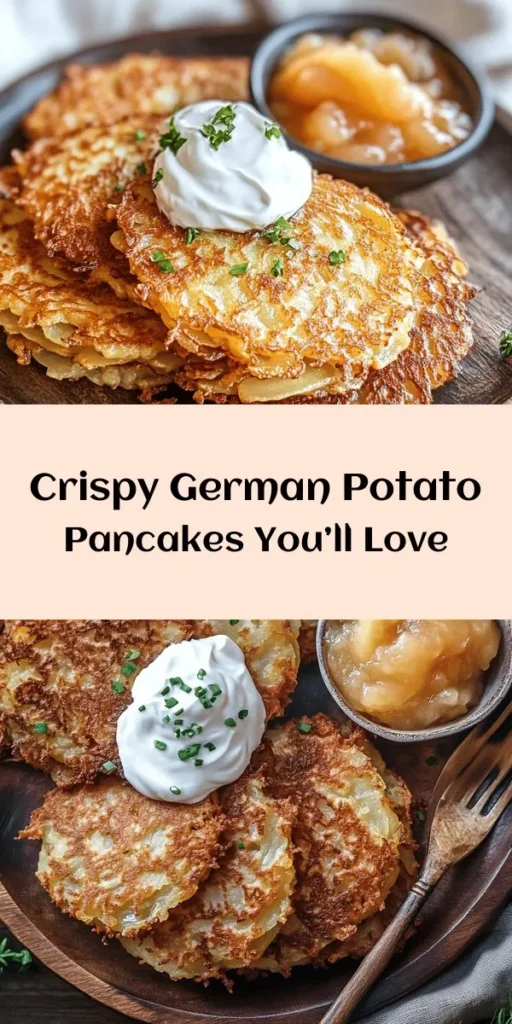Introduction
When it comes to the rich and diverse tapestry of German cuisine, few dishes evoke as much nostalgia and comfort as potato pancakes, known locally as “Reibekuchen” or “Kartoffelpuffer.” These delightful, crispy cakes made from grated potatoes have transcended generations, becoming a cherished staple in households across Germany. Their origins can be traced back to peasant cooking, where the versatility of the potato was celebrated, making it a beloved ingredient in various forms. Potato pancakes are not just a meal; they represent a cultural connection and a tradition that brings families together during gatherings, festivals, and holidays.
In this article, we delve into the authentic recipe for crispy German potato pancakes, showcasing their unique texture and flavor that will transport your taste buds straight to a German kitchen. What makes this recipe stand out is not just its traditional roots, but also its simplicity and the ease with which it can be recreated at home. Whether you’re craving a savory breakfast, a delicious snack, or a side dish for your main course, these potato pancakes are a culinary delight that can be enjoyed at any time of day.
One of the beautiful aspects of potato pancakes is their versatility when it comes to serving options. While many enjoy them with a dollop of applesauce, which adds a sweet and tangy contrast, others prefer the rich creaminess of sour cream. No matter your preference, these accompaniments enhance the experience and make each bite even more satisfying. So, let’s roll up our sleeves and get ready to make some crispy, authentic German potato pancakes that will have everyone asking for seconds!
Understanding the Ingredients
Before diving into the preparation steps, it is essential to understand the key ingredients that come together to create these delicious potato pancakes. Each component plays a vital role in achieving the perfect texture and flavor, ensuring that your pancakes turn out crispy on the outside and tender on the inside.
Starchy Potatoes
The choice of potatoes is crucial for the success of this recipe. Ideally, you want to use starchy varieties such as Russet or Yukon Gold potatoes. These types of potatoes provide the necessary starch content that contributes to the ideal consistency of the pancake batter. Starchy potatoes help create a light and fluffy texture while maintaining a crispy exterior when fried. Avoid waxy potatoes, such as red potatoes or fingerlings, as they contain less starch and can lead to a gummy texture.
Onions
Onions are another important ingredient that adds depth and aroma to the potato pancakes. They contribute a savory flavor that enhances the overall taste of the dish. Finely grated or chopped onions are typically mixed into the batter, infusing the pancakes with their sweet and aromatic characteristics as they cook. The key is to balance the onion flavor so it complements the potatoes without overpowering them.
Eggs
Eggs serve as the binding agent in our potato pancake recipe. They help hold the grated potatoes and other ingredients together, ensuring that the pancakes do not fall apart during the frying process. Additionally, eggs add richness and moisture to the batter, contributing to the pancakes’ overall flavor and texture.
Flour
Flour is an essential ingredient that helps achieve the right consistency for the pancake batter. It absorbs excess moisture from the grated potatoes, allowing for a more structured pancake that holds its shape while cooking. The amount of flour used can vary depending on the water content of the potatoes, so it’s important to adjust accordingly to achieve the desired thickness.
Seasonings
The flavor profile of your potato pancakes is enhanced by a few simple seasonings. Salt and black pepper are the primary seasonings used, providing a well-rounded taste that elevates the dish. Salt helps to bring out the natural flavors of the potatoes and onions, while black pepper adds a touch of warmth and spice. Additionally, a pinch of baking powder can be included to introduce a slight lift to the pancakes, making them even lighter.
Vegetable Oil
Finally, the choice of oil for frying is crucial to achieving that coveted crispy exterior. A neutral-flavored vegetable oil, such as canola or sunflower oil, is ideal for frying potato pancakes. These oils have high smoke points, allowing for quick cooking without burning. The right amount of oil will ensure that the pancakes get golden brown and crispy while remaining tender on the inside.
Preparation Steps for Delicious Potato Pancakes
Now that we have a good understanding of the essential ingredients for our crispy German potato pancakes, let’s move on to the preparation steps. This detailed breakdown will guide you through each stage, ensuring that you achieve the perfect potato pancakes every time.
Preparing the Potatoes
The first step in making authentic German potato pancakes is preparing the potatoes. Begin by selecting your starchy potatoes and peeling them thoroughly. Once peeled, rinse the potatoes under cold water to remove any excess starch on the surface, which can help achieve a crispier texture when frying. After rinsing, it’s time to grate the potatoes.
For best results, use a box grater with the large holes or a food processor with a grating attachment. Grating the potatoes allows them to cook evenly and creates the signature texture of potato pancakes. However, be mindful of the grating technique; you want to avoid making the potato shreds too fine, as this can lead to a mushy consistency.
Draining Excess Water
Once the potatoes are grated, the next crucial step is to drain excess moisture. This step is essential for achieving crispy potato pancakes. After grating, place the shredded potatoes into a clean kitchen towel or cheesecloth. Gather the edges of the towel and twist it to form a pouch, then squeeze out as much water as possible. This process may require some effort, but removing the excess moisture is vital for preventing soggy pancakes.
Alternatively, you can transfer the grated potatoes to a colander and let them sit for about 10 minutes. Afterward, gently press down on the potatoes with a spoon to help remove additional moisture. The goal is to minimize the water content, allowing the starches to bind together effectively when mixed with the other ingredients.
Combining Ingredients
With the potatoes drained and ready, it’s time to combine all the ingredients to create the pancake batter. In a large mixing bowl, add the grated potatoes, finely chopped onions, eggs, and a measured amount of flour. Season the mixture with salt, black pepper, and baking powder if desired.
Using a fork or a spatula, gently mix the ingredients together until just combined. It’s important not to overmix, as this can result in dense pancakes. The mixture should be cohesive but still retain some texture from the grated potatoes. If the batter seems too loose, you can gradually add more flour until you reach the desired consistency.
In the next part of this article, we will cover the frying process, cooking tips, and serving suggestions to ensure your crispy German potato pancakes are a hit at your dining table. Get ready to enjoy a delicious culinary experience that celebrates the authentic flavors of Germany!

Heating the Oil: Guidelines for Achieving the Right Frying Temperature
To create the perfect crispy German potato pancakes, achieving the right frying temperature is crucial. Start by selecting a heavy-bottomed skillet or frying pan, as this will distribute heat evenly and help prevent hot spots that can burn the pancakes. A cast-iron skillet is an excellent choice for this purpose, providing consistent heat retention.
Before adding oil, heat the pan over medium-high heat for about 2-3 minutes. Once the skillet is hot, add enough oil to coat the bottom generously, typically about 1/4 inch deep. For authentic flavor, use a high smoke point oil like vegetable oil, canola oil, or sunflower oil. You may also consider using a mixture of butter and oil to add richness, but be cautious as butter can burn at high temperatures.
To test if the oil is ready, drop a small spoonful of the potato mixture into the pan. If it sizzles immediately, the oil is hot enough. If it doesn’t sizzle, allow the oil to heat a little longer. Maintaining the correct temperature—around 350°F (175°C)—is essential. If the oil is too hot, the pancakes may brown too quickly on the outside while remaining undercooked inside. Conversely, if the oil is not hot enough, the pancakes will absorb too much oil and become greasy.
Forming Pancakes: Techniques for Shaping and Ensuring Even Cooking
Once your potato mixture is ready, it’s time to shape the pancakes. Using a spoon or a small ice cream scoop, take a generous portion of the mixture—about 1/4 cup—and form it into a patty. To ensure even cooking and crispiness, aim for a thickness of about 1/4 inch. Thinner pancakes will cook more quickly and achieve a better texture, while thicker ones may take longer to cook and could result in a soggy center.
Before placing the formed patties into the hot oil, gently flatten them with the back of the spoon or your palm. This step not only helps them cook evenly but also increases the surface area that will become crispy. When ready to fry, carefully slide the patties into the pan, leaving enough space between them to allow for easy flipping.
Frying to Perfection: Timing and Tips for Golden-Brown Pancakes
Frying the pancakes to perfection is a delicate dance of timing and temperature control. Once you place the potato pancakes in the hot oil, let them fry undisturbed for about 4-5 minutes or until they turn a deep golden brown on the bottom. Avoid the temptation to flip them too soon; letting them sit allows for the development of a crispy crust.
When the bottom is golden brown, use a spatula to gently flip each pancake. Be careful while flipping to maintain their shape. Fry the other side for an additional 4-5 minutes until it is also golden brown and crispy. If you’re cooking in batches, you may need to adjust the heat as the oil can cool down with the addition of new pancakes. Keep an eye on the temperature and adjust the heat as necessary to maintain the frying temperature.
Once the pancakes are a beautiful golden brown on both sides, use a slotted spatula to transfer them to a plate lined with paper towels. This will help absorb any excess oil, ensuring your potato pancakes remain crispy.
Draining and Serving: Best Practices for Serving Crispy Pancakes
After frying, it is essential to drain the excess oil from the potato pancakes properly. Place them on a wire rack set over a baking sheet instead of paper towels, if possible. A wire rack allows for airflow around the pancakes, preventing them from becoming soggy from trapped steam.
For serving, crispy potato pancakes are traditionally accompanied by a dollop of sour cream and a side of applesauce. The creamy sour cream adds a rich contrast to the crispy texture, while the sweetness of the applesauce complements the savory flavor of the potatoes. For a more modern twist, consider garnishing with fresh herbs like chives or parsley, which add both color and freshness.
Crispy Texture: The Key to Great Potato Pancakes
Achieving that coveted crispy texture is all about moisture management. Raw potatoes contain a significant amount of water, which, if not properly removed, can lead to soggy pancakes. After shredding the potatoes, place them in a clean kitchen towel and wring out as much moisture as possible. This step is critical; the drier the potato mixture, the crispier the final product will be.
Additionally, the frying technique plays a vital role in enhancing the texture. The oil must be hot enough to create a quick sear on the outside of the pancakes, locking in moisture while allowing steam to escape. This balance is what gives you that perfect crispy exterior paired with a tender interior. Monitoring the cooking temperature and timing will also ensure you avoid burnt edges while keeping the centers properly cooked.
Serving Suggestions and Pairings
When it comes to serving German potato pancakes, tradition reigns supreme. The classic accompaniments are sour cream and applesauce, offering a delightful balance of savory and sweet flavors. The creamy tang of sour cream complements the potato’s earthiness, while the applesauce provides a fruity contrast, enhancing the overall dish.
For those looking to expand their serving repertoire, consider pairing potato pancakes with a fresh salad, such as a simple arugula salad drizzled with lemon vinaigrette. This adds a refreshing component to the meal, balancing the richness of the pancakes. Alternatively, serve the pancakes alongside smoked salmon or crispy bacon for a heartier breakfast or brunch option.
In Germany, potato pancakes are often served during festive occasions and family gatherings, showcasing their cultural significance. They are typically enjoyed during Oktoberfest celebrations or as a comforting dish in winter months, showcasing their versatility as a beloved comfort food.
Nutritional Information
Understanding the nutritional content of your crispy potato pancakes can help you enjoy them mindfully. Each serving (approximately two pancakes) contains around 200-250 calories, depending on the specific ingredients and portion sizes. The pancakes are primarily made up of carbohydrates from the potatoes, with modest amounts of protein and fat from the frying oil.
While potato pancakes are indeed a delicious indulgence, it’s essential to consider health factors. Using healthier oils and serving them with lighter accompaniments can help balance out the dish. For those watching their calorie intake, serving the pancakes with a side of fresh vegetables or a salad can enhance the meal’s nutritional profile without sacrificing flavor.
Conclusion
Crispy authentic German potato pancakes are not just a dish; they are a culinary tradition that brings comfort and joy to many. Their appeal lies in their delightful crunch, savory flavor, and the ability to pair well with various sides and garnishes. Whether enjoyed during festive occasions or as a cozy weeknight meal, these pancakes hold a special place in both traditional and contemporary German cuisine.
With this recipe, you’ll not only get to experience the rich flavors of Germany but also find joy in creating these crispy delights in your own kitchen. The process may seem intricate, but with the right techniques and a little practice, you’ll master these potato pancakes in no time. So gather your ingredients, turn up the heat, and treat yourself and your loved ones to a taste of Germany—one crispy potato pancake at a time.



